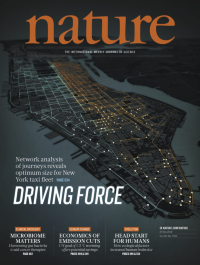Volume 557
-
No. 7707 31 May 2018
On the origin of lizardsThe cover shows an artist’s impression of the Middle Triassic lizard Megachirella wachtleri. Found in the Italian Alps, the fossilized remains of this creature were first described in 2003. In this issue, Tiago Simões and his colleagues unveil a detailed analysis of the fossil using high-resolution microfocus X-ray computed tomography. The results shed fresh light on the origins of squamates — the group of reptiles that includes lizards and snakes. The team found that M. wachtleri is 75 million years older than other oldest known squamate fossils, thereby partially plugging a gap in the fossil record. Their phylogenetic analysis puts the emergence of geckos ahead of iguanians in the evolution of squamates and shows that the initial diversification of the major reptile lineages occurred before the Permian–Triassic boundary 252 million years ago.
Nature Outlook
-
No. 7706 24 May 2018
Driving forceTaxis are a common mode of transport in most of the world’s cities, but is the size of the fleet optimal for the number and nature of trips undertaken? In this issue, Mohammad Vazifeh and his colleagues reveal that it is possible to deploy fewer cabs without causing delays to the passengers or requiring them to share taxis. The team used a network-based approach in which the individual vehicles (not the individual rides) are shared across the transport network, and they tested their scheme against the millions of taxi trips taken in New York City over the course of one year. With prior knowledge of the trips taken, they calculated that the same service could have been provided with a fleet 40% smaller than the one actually used; when the scheme is modified to work from real-time information, a saving of around 30% is possible. The result has implications not only for current taxi fleets but also for the potential deployment of self-driving vehicles in the future. The cover picture captures their optimization model in action: it shows one minute of taxi rides in New York City (dots represent destinations, while lines are trajectories). The right side of the image (yellow lines) represents the current situation; the left side of the image (blue lines) shows the reduced fleet that could be obtained using the team’s model.
Spotlight
-
No. 7705 17 May 2018
How to grow healthy labsA healthy research environment is fundamental to good science. But it is an aspect that is rarely discussed. That’s partly because a lab’s ‘health’ is complex and difficult to assess — it is the product of a whole host of factors, such as inclusivity, communication, expectations and training. In this special issue, Nature explores how the working environment shapes research quality and morale — and what can be done to strengthen the research enterprise. From our survey of more than 3,000 researchers to first-hand experiences of how to nurture and improve research culture, we unpick the issues that can derail a lab and that can help make it the best place to work.
Insight
-
No. 7704 10 May 2018
Butterfly effectIn 1993, a paper published in Nature showed that an isolated population of Edith’s checkerspot butterfly (Euphydryas editha) in a meadow in Carson City, Nevada, was starting to evolve a preference for the non-native plant Plantago lanceolata, which was introduced to the region through cattle ranching. Twenty-five years on, in this week’s issue, Michael Singer and Camille Parmesan show how the butterfly population ended up evolving complete dependence on the exotic plant. As a result, after cattle ranching ceased in 2005 and Plantago became briefly embedded in cool, lush grasses, the butterfly population went extinct. In 2013–4, a natural recolonization returned the insects to their traditional host, and their diet to its starting point. The findings illustrate the potentially lethal eco-evolutionary traps that human activities can unwittingly create for natural populations, and the importance of taking these traps into account in the conservation of human-modified habitats.
Spotlight
-
No. 7703 3 May 2018
Lifeline for liversA key limiting factor for successful liver transplants is the availability and quality of donor organs. In this issue, David Nasralla, Constantin Coussios, Peter Friend and colleagues report the outcomes from a trial investigating a new method of liver preservation prior to transplantation. Normally, a donor liver is preserved in ice, but this can cause damage to the organ. The researchers tackled this problem by deploying a technique called normothermic machine perfusion (NMP). This maintains the donor organs at body temperature and takes deoxygenated blood from the liver into a machine where it is oxygenated and bolstered with crucial nutrients before being pumped back into the liver. The technique allowed more donor livers to be transplanted having been preserved up to 54% longer and, despite this, reduced graft injury by 50% compared with organs preserved on ice. The team hopes that NMP could increase the number of viable organs available for transplant operations.





